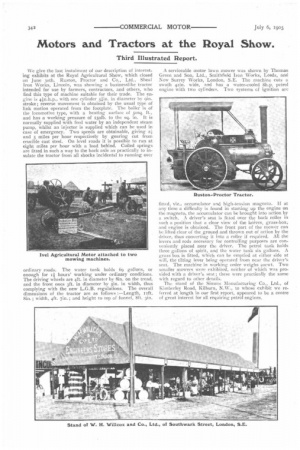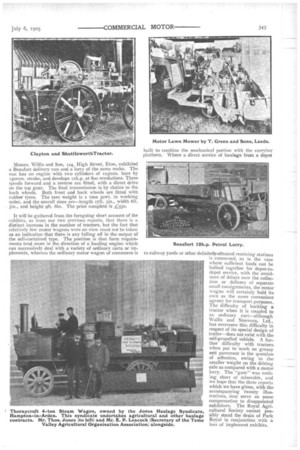Motors and Tractors at the Royal Show.
Page 22

Page 23

If you've noticed an error in this article please click here to report it so we can fix it.
Third Illustrated Report.
We give the last instalment of our description of interesting exhibits at the Royal Agricultural Show, which closed on June 30th. Ruston, Proctor and Co., Ltd., Sheaf Iron Works, Lincoln, was showing a businesslike tractor intended for use by farmers, contractors, and others, who find this type of machine suitable for their trade. The engine is 4t-n.h.p., with one cylinder din. in diameter by sin. stroke; reverse movement is obtained by the usual type of link motion operated from the footplate. The boiler is of the locomotive type, with a heating surface of 5osq. ft., and has a working pressure of 15olb. to the sq. in. It is normally supplied with feed water by an independent steam pump, whilst an injector is supplied which can be used in case of emergency. Two speeds are obtainable, giving 2:1 and 5 miles per hour respectively by gearing cut from crucible cast steel. On level roads it is possible to run at eight miles per hour with a load behind. Coiled springs are fitted in such a way to the back axle as practically to insulate the tractor from all shocks incidental to running over
ordinary roads. The water tank holds 69 gallons, or enough for ethours' working under ordinary conditions. The driving wheels are 4ft. in diameter by 8in, on the tread, and the front ones 3ft. in diameter by sin. in width, thus complying with the new L.G.B. regulations. The overall dimensions of the tractor are as follows :—Length, iift. 8in.; width, 4ft. 710.; and height to top of funnel, 8ft. sin. A serviceable motor lawn mower was shown by Thomas Green and Son, Ltd., Smithfield Iron Works, Leeds, and New Surrey Works, London, S.E. The machine cuts a swath 4210. wide, and has a water-cooled 8h.p. petrol engine with two cylinders. Two systems of ignition are
fitted, viz., accumulator and high-tension magneto. If at any time a difficulty is found in starting up the engine on the magneto, the accumulator can be brought into action by a switch. A driver's seat is fitted over the back roller in such a position that a clear view of the knives, grass-box, and engine is obtained. The front part of the mower can be lifted clear of the ground and thrown out of action by the driver, thus converting it into a roller if required. All the levers and rods necessary for controlling purposes are conveniently placed near the driver. The petrol tank holds three gallons of spirit,. and the water tank six gallons. A grass box is fitted, which ean be emptied at either side at will, the tilting lever being operated from near the driver's seat. The machine in working order weighs ocwt. Two smaller mowers were exhibited, neither of which was provided with a driver's seat ; these were practically the same with regard to other details.
The stand of the Simms Manufacturing Co., Ltd., of Kimberley Road, Kilburn, N.W., to whose exhibit we referred at length in our first report, appeared to be a centre of great interest for all requiring petrol engines. Messrs. Willis and Son, 124, High Street, Eton, exhibited a Beaufort delivery van and a lorry of the same make. The van has an engine with two cylinders of 125mm. bore by isomm. stroke, and develops 12h.p. at 800 revolutions. Three speeds forward and a reverse are fitted, with a direct drive on the top gear. The final transmission is by chains to the back wheels. Both front and back wheels are fitted with rubber tyres. The tare weight is 2 tons scwt. in working order, and the overall sizes are—length x7ft. 3in., width 6ft. sin., and height gft. 61n. The price complete is Z'sso.
It will be gathered from the foregoing short account of the exhibits, as from our two previous reports, that there is a distinct increase in the number of tractors, but the fact that relatively few motor wagons were on view must not be taken as an indication that there is any falling off in the output of the self-contained type. The position is that farm requirements tend more in the direction of a hauling engine which can successively deal with a variety of ordinary carts or implements, whereas the ordinary motor wagon of commerce is
to railway yards or other definitely-situated receiving stations is concerned, as is the case where sufficient loads can be bulked together for depot-todepot service, with the avoidance of delays over the collection or delivery of separate small consignments, the motor wagon will certainly hold its own as the more convenient agency for transport purposes. The difficulty of backing a tractor when it is coupled to an ordinary cart—although Wallis and Steevens, Ltd., has overcome this difficulty in respect of its special design of trailer—does not exist with the self-propelled vehicle. A further difficulty with tractors when put to work on greasy sett pavement is the question of adhesion, owing to the smaller weight on the driving axle as compared with a motor lorry. The "gate" was nothing short of miserable, and we hope that the three reports which we have given, with the accompanying twenty illustrations, may serve as some compensation to disappointed exhibitors. The Royal Agricultural Society cannot possibly stand the drain of Park Royal in conjunction with a loss of implement exhibits.


























